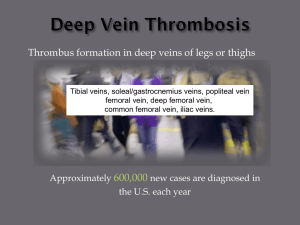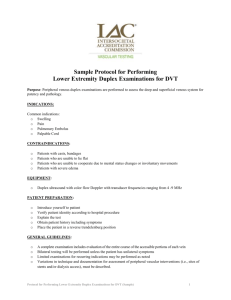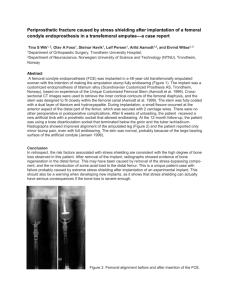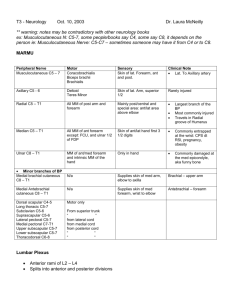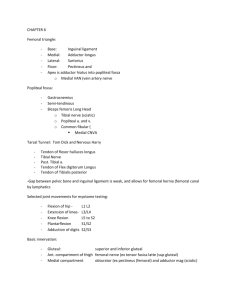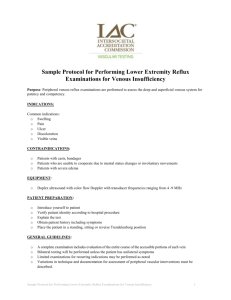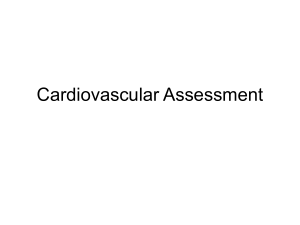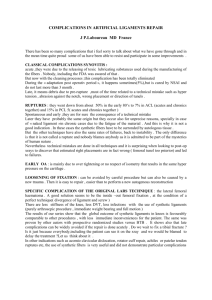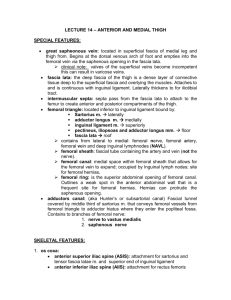LOs for Anterior and Medial thigh
advertisement
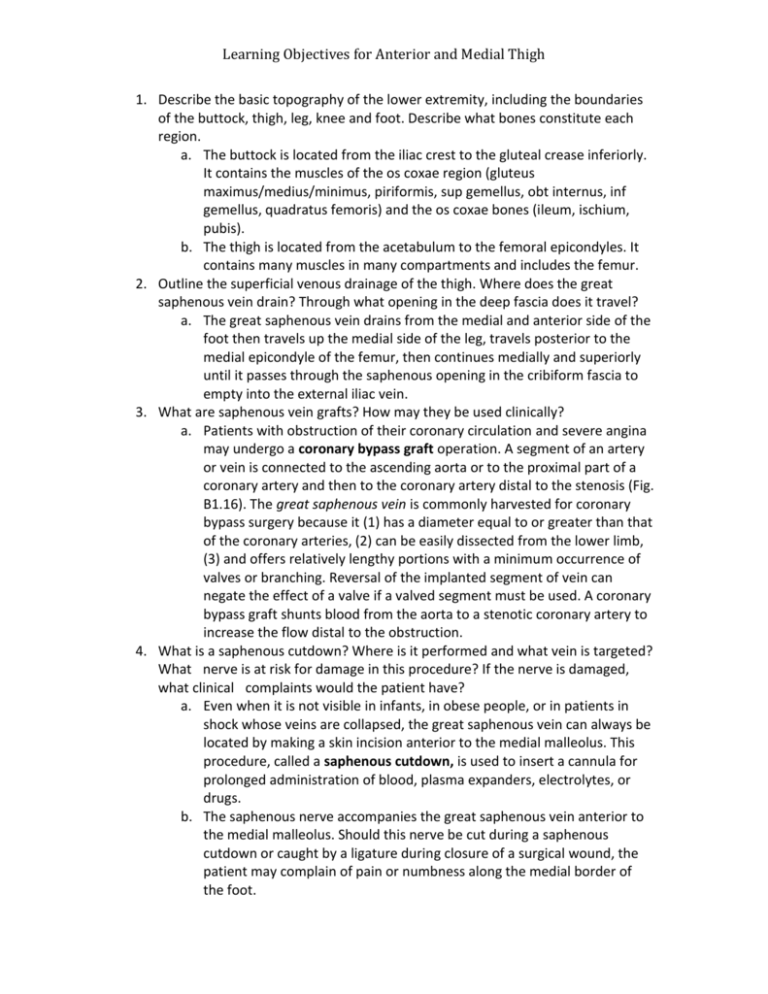
Learning Objectives for Anterior and Medial Thigh 1. Describe the basic topography of the lower extremity, including the boundaries of the buttock, thigh, leg, knee and foot. Describe what bones constitute each region. a. The buttock is located from the iliac crest to the gluteal crease inferiorly. It contains the muscles of the os coxae region (gluteus maximus/medius/minimus, piriformis, sup gemellus, obt internus, inf gemellus, quadratus femoris) and the os coxae bones (ileum, ischium, pubis). b. The thigh is located from the acetabulum to the femoral epicondyles. It contains many muscles in many compartments and includes the femur. 2. Outline the superficial venous drainage of the thigh. Where does the great saphenous vein drain? Through what opening in the deep fascia does it travel? a. The great saphenous vein drains from the medial and anterior side of the foot then travels up the medial side of the leg, travels posterior to the medial epicondyle of the femur, then continues medially and superiorly until it passes through the saphenous opening in the cribiform fascia to empty into the external iliac vein. 3. What are saphenous vein grafts? How may they be used clinically? a. Patients with obstruction of their coronary circulation and severe angina may undergo a coronary bypass graft operation. A segment of an artery or vein is connected to the ascending aorta or to the proximal part of a coronary artery and then to the coronary artery distal to the stenosis (Fig. B1.16). The great saphenous vein is commonly harvested for coronary bypass surgery because it (1) has a diameter equal to or greater than that of the coronary arteries, (2) can be easily dissected from the lower limb, (3) and offers relatively lengthy portions with a minimum occurrence of valves or branching. Reversal of the implanted segment of vein can negate the effect of a valve if a valved segment must be used. A coronary bypass graft shunts blood from the aorta to a stenotic coronary artery to increase the flow distal to the obstruction. 4. What is a saphenous cutdown? Where is it performed and what vein is targeted? What nerve is at risk for damage in this procedure? If the nerve is damaged, what clinical complaints would the patient have? a. Even when it is not visible in infants, in obese people, or in patients in shock whose veins are collapsed, the great saphenous vein can always be located by making a skin incision anterior to the medial malleolus. This procedure, called a saphenous cutdown, is used to insert a cannula for prolonged administration of blood, plasma expanders, electrolytes, or drugs. b. The saphenous nerve accompanies the great saphenous vein anterior to the medial malleolus. Should this nerve be cut during a saphenous cutdown or caught by a ligature during closure of a surgical wound, the patient may complain of pain or numbness along the medial border of the foot. Learning Objectives for Anterior and Medial Thigh 5. Describe the deep veins of the thigh. What is deep vein thrombosis? How is it characterized clinically—what symptoms would the patient have? a. The deep veins of the thigh include the femoral vein and the deep vein of the thigh. Deep venous thrombosis (DVT) of one or more of the deep veins of the lower limb is characterized by swelling, warmth, and erythema (inflammation) and infection. 6. What are varicose veins in the lower limb? What is incompetent in this condition? In what direction does the blood flow to create varicose veins? a. Frequently, the great saphenous vein and its tributaries become varicose (dilated so that the cusps of their valves do not close). Varicose veins are common in the posteromedial parts of the lower limb and may cause discomfort (Fig. B5.6). In a healthy vein the valves allow blood to flow toward the heart while keeping blood from flowing away from the heart. Valves in varicose veins are incompetent due to dilation or rotation and no longer function properly. As a result, blood flows inferiorly in the veins, producing varicose veins. 7. Describe the lymphatic drainage of the lower limb, tracing it all the way back to the thoracic duct. What is lymphadenopathy? When inguinal nodes are enlarged, what areas should be examined to determine the cause of their enlargement? a. Lymph nodes enlarge when diseased. Abrasions and minor sepsis, caused by pathogenic microorganisms or their toxins in the blood or other tissues, may produce moderate enlargement of the superficial inguinal lymph nodes (lymphadenopathy) in otherwise healthy people. Because these enlarged nodes are located in subcutaneous tissue, they are usually easy to palpate. b. When inguinal lymph nodes are enlarged, their entire field of drainage— the trunk inferior to the umbilicus, including the perineum, as well as the entire lower limb—should be examined to determine the cause of their enlargement. In female patients, the relatively remote possibility of metastasis of cancer from the uterus should also be considered because some lymphatic drainage from the uterine fundus may flow along lymphatics accompanying the round ligament of the uterus through the inguinal canal to reach the superficial inguinal lymph nodes. 8. Outline the major muscle attachments to the various bony landmarks on the femur, as outlined in the notes and in Grant’s Dissector. a. Vastus lateralis: origin – lat lip of linea aspera and greater trochanter b. Vastus medialis: origin – med lip of linea aspera and intertrochanteric line c. Vastus intermedius: origin – ant & lat surfaces of the shaft of the femur d. Pectineus: insertion – pectineal line of femur (inf to lesser trochanter) e. Iliopsoas: Insertion – lesser trochanter of femur f. Adductor longus: insertion – med side of linea aspera (inf) g. Adductor brevis: Insertion – med side of linea aspera (sup) h. Adductor magnus: insertion (hamstring part) – adductor tuberosity of the Learning Objectives for Anterior and Medial Thigh femur (above medial epicondyle) i. Insertion (adductor part): linea aspera i. Obturator externus: insertion – trochanteric fossa of the femur 9. Describe the fascial organization of the lower extremity and how this fascia compartmentalizes the thigh into compartments. What is the major function of each compartment? What is the innervation and blood supply of each compartment? What muscles are found in each compartment? a. Anterior compartment b. Medial compartment 10. How would paralysis of the quadriceps femoris present? How would you test for this clinically? a. A person with paralyzed quadriceps muscles cannot extend the leg against resistance and usually presses on the distal end of the thigh during walking to prevent inadvertent flexion of the knee joint. Weakness of the vastus medialis or vastus lateralis, resulting from arthritis or trauma to the knee joint, can result in abnormal patellar movement and loss of joint stability. 11. What is the femoral triangle? What are its boundaries and contents? a. The femoral triangle is a subfascial space in the anterosuperior third of the thigh (Fig. 5.14). It appears as a triangular depression inferior to the inguinal ligament when the thigh is flexed, abducted, and laterally rotated. The femoral triangle is bounded: i. Superiorly by the inguinal ligament, which forms the base of the femoral triangle. ii. Medially by the adductor longus. iii. Laterally by the sartorius; the apex is where the medial border of the sartorius crosses the lateral border of the adductor longus. b. The muscular floor of the femoral triangle is formed by the iliopsoas laterally and pectineus medially (Fig. 5.14C). The roof of the femoral triangle is formed by fascia lata, cribriform fascia, subcutaneous tissue, and skin. c. The contents of the femoral triangle, from lateral to medial, are the (Fig. 5.14): i. Femoral nerve and its (terminal) branches. ii. Femoral artery and several of its branches. iii. Femoral vein and its proximal tributaries (e.g., the great saphenous vein and deep femoral veins). iv. Femoral canal. v. Deep inguinal lymph nodes and associated lymphatic vessels. 12. What makes up the femoral sheath? What is found within the femoral sheath? a. The femoral sheath is a funnel-shaped, fascial tube of varying length (usually 3 to 4 cm) that passes deep to the inguinal ligament and encloses proximal parts of the femoral vessels and creates the femoral canal medial to them (Fig. 5.15). The sheath is formed by an inferior Learning Objectives for Anterior and Medial Thigh prolongation of the transversalis and iliopsoas fascia from the abdomen/greater pelvis. 13. What is a femoral hernia? Where does this type of hernia typically occur and how does it present clinically? How does the position of this type of hernia relate to the inguinal ligament? a. The femoral ring is a weak area in the lower anterior abdominal wall that is the site of a femoral hernia, a protrusion of abdominal viscera (often a loop of small intestine) through the femoral ring into the femoral canal (Fig. B5.7). A femoral hernia is more common in women than in men. The hernial sac compresses the contents of the femoral canal and distends its wall. Initially, the hernia is relatively small because it is contained within the femoral canal, but it can enlarge by passing through the saphenous opening into the subcutaneous tissue of the thigh. Strangulation of a femoral hernia may occur and interfere with the blood supply to the herniated intestine, and vascular impairment may result in death of the tissues. 14. Where is a femoral nerve block administered? Why might your patient experience paresthesia (tingling) radiating to the knee and over the medial side of the leg after this block? a. Interruption of the conduction of impulses in peripheral nerves (nerve block) may be achieved by making perineural injections of anesthetics close to the nerves whose conductivity is to be blocked. b. The femoral nerve (L2-L4) can be blocked 2 cm inferior to the inguinal ligament, approximately a finger's breadth lateral to the femoral artery. Paresthesia (tingling, burning, tickling) radiates to the knee and over the medial side of the leg if the saphenous nerve (terminal branch of femoral) is affected. 15. What is a “hip pointer”, or contusion of the iliac crest at the ASIS? What muscle attaches here? a. Sports broadcasters and trainers refer to a “hip pointer,” which is a contusion of the iliac crest that usually occurs at its anterior part. b. The term hip pointer may also refer to avulsion of bony muscle attachments, for example, of the sartorius or rectus femoris to the anterior superior and inferior iliac spines respectively. 16. What is a “charley horse”? a. Another term commonly used is “charley horse,” which may refer either to the cramping of an individual thigh muscle because of ischemia, or to contusion and rupture of blood vessels sufficient to form a hematoma. The injury is usually the consequence of tearing of fibers of the rectus femoris; sometimes the quadriceps tendon is also partially torn. A charley horse is associated with localized pain and/or muscle stiffness and commonly follows direct trauma. 17. What is a psoas abscess? Where can it spread? How does it present clinically? Learning Objectives for Anterior and Medial Thigh a. An abscess resulting from tuberculosis in the lumbar region tends to spread from the vertebrae into the psoas sheath, where it produces a psoas abscess. As a consequence, the psoas fascia thickens to form a strong stocking-like tube. Pus from the psoas abscess passes inferiorly along the psoas within this fascial tube over the pelvic brim and deep to the inguinal ligament. The pus usually surfaces in the superior part of the thigh. Pus can also reach the psoas sheath by passing from the posterior mediastinum when the thoracic vertebrae are diseased 18. What is the patellar reflex and what spinal cord levels does it test? a. Tapping the patellar ligament with a reflex hammer normally elicits the patellar reflex (“knee jerk”). This myotatic (deep tendon) reflex is routinely tested during a physical examination by having the person sit with the legs dangling. A firm strike on the ligament with a reflex hammer usually causes the leg to extend. If the reflex is normal, a hand on the person's quadriceps should feel the muscle contract. This tendon reflex tests the integrity of the femoral nerve and the L2-L4 spinal cord segments. Diminution or absence of the patellar tendon reflex may result from any lesion that interrupts the innervation of the quadriceps (e.g., peripheral nerve disease).
